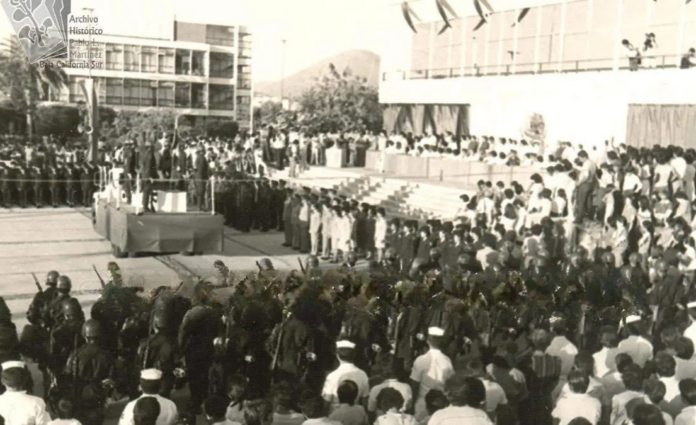On the occasion of the 51st anniversary of the territory’s conversion to a free and sovereign state, authorities from the three branches of government and representatives of civil society participated this Wednesday, October 8, in a solemn public session held at the State Congress.
Receive the most important news from Baja California Sur through our newsletter!
The event took place within the framework of the First Ordinary Session of the Second Year of Constitutional Exercise of the XVII Legislature, with the presence of Governor Víctor Manuel Castro Cosío, the presiding judge of the Superior Court of Justice, Claudia Jeanette Cota Peña, and Representative Cristina Contreras Rebollo, representing the Legislative Branch.
During her speech, Representative Cristina Contreras Rebollo recalled that more than half a century ago, one of the most important political transformations in the history of Baja California Sur took place.
“Fifty-one years ago, the Congress of the Union approved the constitutional reforms that recognize us as the 31st state of the Mexican Federation. This anniversary is not only one of pride, but also of reflection and commitment to continue advancing the well-being of the people of Baja California Sur,” she said.
She mentioned that the state’s conversion was the result of decades of social and political effort.
“In 1945, the South Californian Unification Front was born, which promoted the demand that we be able to elect our authorities and our destiny. Decades later, the Loreto 70 movement reaffirmed that aspiration, and finally, on October 8, 1974, the decree that amended Article 43 of the Constitution was published in the Official Gazette of the Federation,” she explained.
The legislator emphasized that, one year after that decree, the first constitutional governor of Baja California Sur, Ángel César Mendoza Arámburo, was elected, and the Constituent Congress charged with drafting the first state Constitution was formed.
“We pay tribute to those who gave us our legal framework: María Luisa Salcedo Morales, Armando Trasviña Taylor, Eligio Soto López, Armando Aguilar Paniagua, Armando Santisteban Cota, Fernando Cota Sández, and Manuel Davis Ramírez,” she added.
For her part, Chief Justice Claudia Jeanette Cota Peña noted that October 8, 1974, marked a turning point in the political and legal history of Baja California Sur.
“During the federal territory era, justice was administered from the nation’s capital; it was burdensome and slow for the citizens of Baja California Sur. The political transformation that began in 1974 brought the possibility of all common-court judicial proceedings being carried out within our territorial jurisdiction, marking a before and after,” she explained.
She emphasized that in these 51 years, the Judiciary has evolved with the creation of more courts and tribunals, the consolidation of the Judicial Council, the implementation of the online trial system, and the updating of its organic laws.
“Our state has had nine governors elected by citizen vote, from different national political forces, who have worked throughout these more than five decades to improve the quality of life of our people,” the judge added.
Representing civil society, the rector of the Autonomous University of Baja California Sur (UABCS), Dante Arturo Salgado González, highlighted the role that educational institutions have played in the state’s democratic development.
He noted that the transition from territory to state also involved the construction of a distinct identity and the consolidation of an active and participatory citizenry.
During his speech, Governor Víctor Manuel Castro Cosío recognized the importance of keeping alive the historical memory of the events that gave rise to South Californian sovereignty.
“Beyond ideologies, we are united by our homeland, South California. I thank the representatives for making this day of remembrance a special day. This republican exercise is part of what we must strengthen: the clarity of seeing these events not only as protocols, but as an opportunity to strengthen state institutions for the well-being of the people,” he expressed.
At the end of the speeches, the Baja California Sur State Anthem, “Orgullo Sudcaliforniano,” was sung, with lyrics by Domingo Valentín Castro Burgoin and music by Alfredo Clayton Hernández, bringing the solemn ceremony to a close.
From Territory to Free and Sovereign State
The Southern Territory of Baja California was established in 1931, after the Congress of the Union amended Article 43 of the Constitution to divide the peninsula into two entities: Baja California and the Southern Territory of Baja California.
For more than four decades, government and judicial decisions depended on federal power.
In 1945, the South Californian Unification Front began the fight for the right to elect local authorities. Beginning in 1970, the “Loreto 70” movement revived the demand by collecting thousands of citizen signatures.
Finally, on October 8, 1974, under the government of President Luis Echeverría Álvarez, the decree establishing Baja California Sur as a free and sovereign state, along with Quintana Roo, was published.
A year later, on April 6, 1975, the first local elections were held, in which Ángel César Mendoza Arámburo was elected as the first constitutional governor.
That same year, the Constituent Congress was established, responsible for drafting the Political Constitution of the State of Baja California Sur, promulgated on January 15, 1975.
Since then, the state has had 17 legislatures and issued more than 150 state laws regulating various aspects of political, social, and economic life. In the judicial sphere, the creation of local courts marked the full autonomy of the Baja California Sur justice system.

Source: oem




